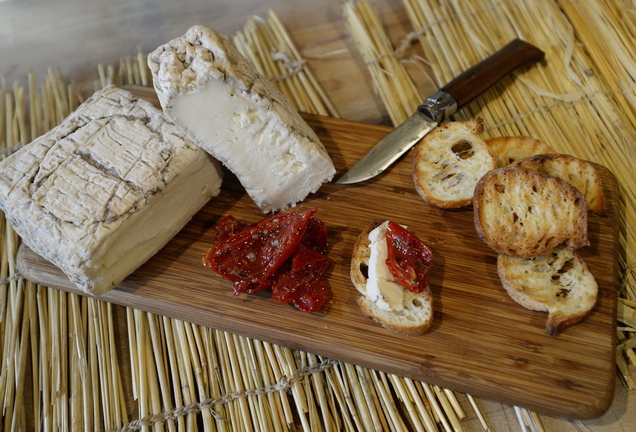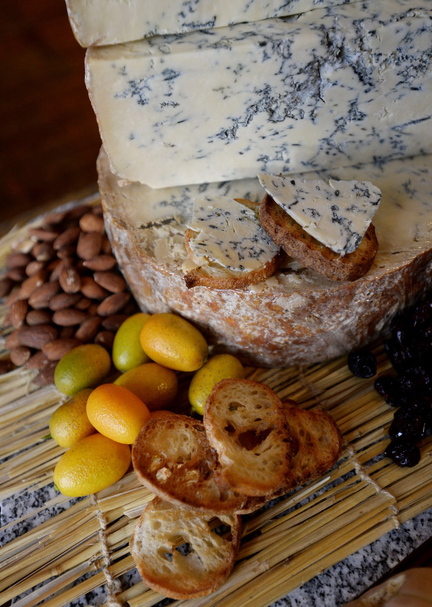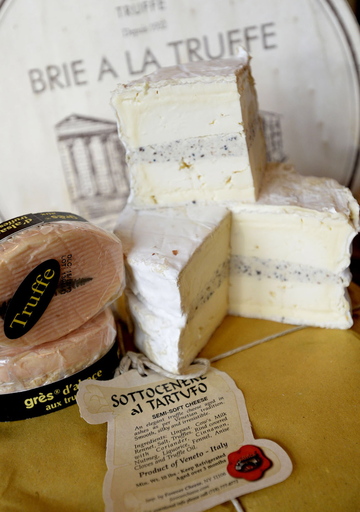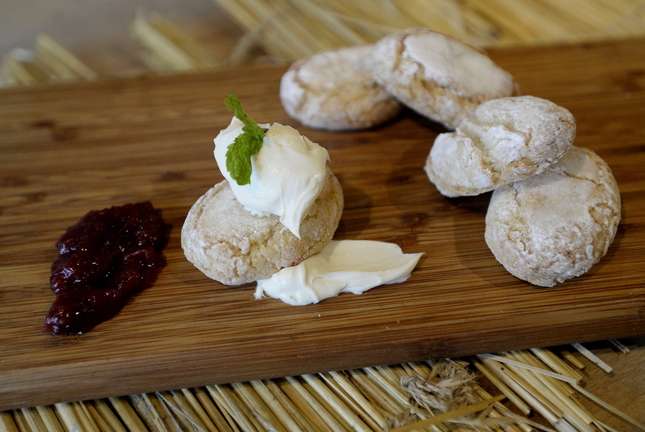Cheese has become a much more popular addition to the holiday table, but standing in front of a cheese counter these days is like standing in the cereal aisle at the grocery store – so many choices, the head starts to spin.
If you’re unsure about what kind of cheese to buy, how to serve it, and whether to pair it with crackers or fruit (or leave it naked), don’t be afraid to ask questions of the cheesemaker or cheesemonger. That’s what they’re there for, and a little knowledge goes a long way. If there’s a cheese you’re interested in, be bold and ask for a small taste; that’s standard procedure these days.
This year I’ve done some advance work for you. I’d like to pretend that this was a terrible hardship and bask in the glow of your admiration, but I’d be lying, of course. Good cheese is one of my favorite things, and the main reason I could never be a vegan. When my time comes, I’m sure they’ll find me clutching some sort of moldy French stinky cheese.
I asked a couple of local experts to offer some suggestions for cheeses to serve your guests.
The first expert is known by cheese junkies everywhere in southern Maine: Vince Maniaci, proprietor (along with his wife, Jill Dutton) of The Cheese Iron in Scarborough.
The second is Shannon Tallman, cheese buyer at Whole Foods, who recently became a certified cheese professional. That’s kind of like becoming a cheese sommelier, and to do it she had to pass a written test with 150 questions and sample more than 100 cheeses in four days. (Where do I sign up?)
All of their suggestions can be found in their own stores, of course, but many of them are also available at any well-stocked local cheese shop. Both of these stores also carry lots of local cheeses, but if Maine cheeses are mainly what you want, K. Horton Specialty Foods in the Public Market House has a large selection.
Let’s jump right in and start off with some simple suggestions for your holiday table. I’ll follow that up with some advice on pairing cheese with crackers and fruit; suggestions for expanding your cheese horizons; and end by telling the story of some cheeses that will give you something to talk about at your holiday party:
• Maniaci’s first recommendation is easy and affordable. Take an almond-flavored Ricciarelli (a gluten-free Italian cookie), top it with a dollop of mascarpone (a creamy Italian cheese you can find at any grocery store) and maybe a little raspberry preserves. Delicious.
Or try toasting some Pannetone, a traditional Italian sweetbread loaf available everywhere during the holidays, and smear it with some mascarpone or fresh, creamy sheep’s milk cheese.
Sheep’s milk cheese is “better for your heart, too, because it’s high in alpha linolenic acids,” Maniaci said. “A lot of dietitians in Europe will recommend 50 grams of sheep’s milk and/or alpine cheese because of its lanolin properties. That’s good for the arterial lining of your heart.”
• From good-for-you to good golly: Take some Camembert out of the fridge and, while it’s still cold, cut it in half and add some slivered almonds and Adriatic fig jam. Then put it back together, double dredge it in egg wash and panko bread crumbs, and deep fry about four minutes or until golden brown. The oil should be at 375 degrees.
“It’s decadent,” Maniaci said, “but if you do it once a year, you’re fine.”
• Need an easy meal during the busy holiday rush? Buy some raclette, a semi-firm cow’s milk cheese that comes in wheels. In Europe, this cheese is melted in front of a fire or using a special machine, then the melted part is scraped onto plates. Here, you can just place thick slices of raclette on a nonstick pan and put it under the broiler until it’s golden brown. Then pour it onto roasted vegetables or even some flank steak. On the side, make sure you have some mustard, pickles, onion jam and big pieces of crusty bread.
• The first two weeks Maniaci was in the cheese business, he ate nothing but taleggio for dinner every night, with a crusty baguette, some roasted tomatoes and anchovies.
“This is the cheese that actually was my first cheese love,” he said. “This is the cheese I fell in love with, and it’s been hard to find until recently. There are a lot of these on the market, but a lot of them are very sort-of commodity, industrialized taleggio.”
Now he has in stock some artisan raw milk, cave-aged taleggio from the Lombardy region of Italy. The high humidity and low temperature of the cheese cave slows down lactic fermentation so that the creamy cheese develops a nice briny, earthy finish and doesn’t have the extra tang that lingers with other taleggios.
• If you’re one of those people who can’t get enough truffles, The Cheese Iron decided to go all out this holiday season and ordered a big shipment of truffled cheeses from France.
• If they made a list of one of life’s simple pleasures, surely Stilton from the century-old Colston Bassett Dairy would be on it.
“They’re the only dairy that’s had only four cheesemakers in its existence so far,” Maniaci said. “Usually, these days, it’s a revolving door. They learn the trade and they move on. We love (Colston Bassett Stilton) this time of year not because it’s popular and people love it with port, but because when it comes to fruition, it’s the result of that nice late spring grass that (the cows have) been eating, which is a sweet grass. If you have Stilton in the summer, they’ve been eating hay and fodder. And what they eat really translates into the quality of milk, which translates into the quality of cheese.”
If you think you don’t like blue cheese and eating it straight would be too much for you, try a little in a salad with winter pears. Or pair it with some apple for a different kind of side salad.
• But wait, there’s more. Another excellent choice in blue cheese is Rogue River Blue, which is made in Oregon and (I know this from personal experience) will give you an experience I can only describe as a “blue cheese high.” It is not as strong as the Colston Bassett Stilton – its blue veins run thin and spotty – so this could be a good transitional cheese for someone who wants to try blue but has been afraid of it or turned off by the mold.
Be warned: It runs about $40 a pound, but it’s worth it.
“This to me is the best blue cheese being made in the U.S.,” Whole Foods’ Tallman said. “It’s won best in show multiple times at the Cheese Society awards. It’s salty, it’s sweet. It was featured in Saveur magazine about four or five years ago in an article on ports, where they completely committed blasphemy by saying ‘Forget Stilton, serve this with ports.’ ”
What makes it so good? For one thing, it’s wrapped in Syrah grape leaves that have been soaked in pear brandy.
The cheese is made from certified-sustainable Brown Swiss and Holstein cow’s milk, according to the Rogue River website: “The cows graze in 1,250-foot-elevation pastures bordering Rogue River, where they eat a variety of pasture and native grasses, hop clover, wild herbs, Himalayan blackberries and wild flowers, supplemented with grass hay, alfalfa and grain off the ranch.”
CRACKERS, BREAD, FRUIT OR ???
Let’s face it, when we serve cheese at a party we automatically put out crackers, bread or fruit. Why? It just seems like it’s the right thing to do.
But that’s not necessarily the case.
If it’s a hard cheese you’re serving, a cracker, piece of toast or slice of baguette is just a vehicle to get the cheese into your body, says Tallman. You can forget those pairings and just serve the cheese “naked.”
Maniaci agrees. “You’re just going to eat it like candy,” he said. “You’re going to pick it up and pop it into your mouth, or you’re going to put it on a little slice of salami. It’s not always necessary to have a cracker or a baguette with a piece of cheese.”
If it’s a really rich and oozy cheese, spread it on bread the way you would spread it on butter. As a general rule, pair creamy cheeses with something crunchy, like a crusty baguette.
If the cheese is soft but still has some spring to it, go with a cracker. “I tend to lean away from very dense, brittle crackers because I think they give you too much Cap’n Crunch mouth and can ruin the experience,” Tallman said. “Don’t get in the way of the cheese.”
Unflavored, communion-wafer-thin water crackers are a better choice.
More expensive cheeses should be paired with plain crackers and bread, not those fancier brands studded with rosemary, garlic or other herbs. The flavor of the cracker shouldn’t interfere with the flavor of the cheese.
Fruit works well with cheese because it gives an instant sensation of salty-and-sweet in your mouth. It doesn’t have to be fresh fruit. Try some dried dates, dried apricots or a sliver of a dried fig.
Tallman prefers goat cheese served with pomegranate seeds. Just put some seeds on the bottom of a ramekin, mold the cheese on top, and refrigerate it overnight before unmolding it for serving.
Even citrus is OK, although you should probably avoid tropical fruits. If you’re serving an aged goat cheese or an aged sheep’s milk cheese, try clementines for a little burst of acidity.
“With cheeses, there are rules, but then there are no rules,” Tallman said. “It really comes down to what do you like, what can you get a hold of, and really knowing your guests.”
TELL ME ABOUT THAT CHEESE AGAIN
Some cheeses have a great back story – an interesting little tale of how they are made, where they are made, and so on. These little stories can be very popular with your guests, as I found out one year after Maniaci sold me some Vacherin Mont D’or.
Vince told me the story of how the cheese, produced in the Swiss and French alps, is made from the first milking in the fall after the cows have come down from the alpine region. (And the winter milk of the same cows that produce Gruyère in the summer.) In Switzerland, by law, Vacherin Mont D’or has to be produced at elevations of 2,297 feet or higher.
The cheese is wrapped in spruce and lives in its own little wooden box. It’s only available for a few months. Even its name is romantic: It means “cow of the golden mountain.”
This is a decadent, ooey-gooey cheese that you wrap in foil and bake in the oven for about 20 minutes. Scoop up its rich, luscious goodness with a cracker, or ladle the cheese onto some potatoes. And while you’re eating it, tell the story of how it’s made. I served Vacherin Mont D’or at a Thanksgiving gathering a few years ago, told the little story, and people still talk about it.
• Reblochon is a soft, washed rind cow’s milk cheese from France that smells a little like chestnut honey.
Its story dates to the Middle Ages, when farmers were taxed according to the amount of milk their cows produced.
“As the tax man would come to tax their yields, the farmer would always leave a little bit of extra milk in the udder,” Maniaci said. “So after the tax man left, they would do that second milking. They would shake the udder twice, and the second milking would be theirs that they didn’t have to pay taxes on. So they’re cheating the tax man.”
That second milking was also richer and made a better cheese. In the 16th century, farmers offered the cheese to monks in return for having their homesteads blessed.
• Chesire Appleby from Neal’s Yard Dairy is the oldest English cheese on record.
“They say it goes back to the Domesday Book of 1,086,” Tallman said.
It may even have been made by the Romans 1,000 years earlier.
Chesire Appleby looks like an orange cheddar and is “the last traditionally made, clothbound, unpasteurized cheddar.” In other words, it’s made the same way English farmers made their cheddar 100 years ago.
Staff Writer Meredith Goad can be contacted at 791-6332 or at:
mgoad@pressherald.com
Twitter: MeredithGoad
Send questions/comments to the editors.







Comments are no longer available on this story